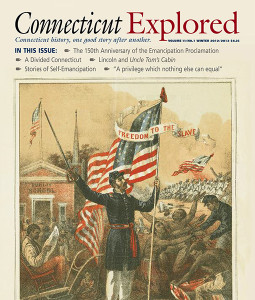(c) Connecticut Explored Inc. Winter 2012-2013
Subscribe/Buy the Issue!
True or False:
____ Connecticut was a slave colony/state for more than 200 years.
____ Slavery in Connecticut was more benign than it was in the South.
____ Connecticut was a stronghold of abolitionism, and our soldiers went off to fight the Civil War to free those held in slavery.
If you were a Connectican in 1861, you would know the answers: true, false, and false. You would know that legalized slavery was not completely abolished in our state until 1848, that court cases revealed abuse and cruel treatment of enslaved men and women, and that preserving the Union was paramount in most white Connecticans’ minds on the eve of the Civil War. Though Connecticut was home to some of the most prominent abolitionists in the North—notably Hartford’s Harriet Beecher Stowe, Torrington’s radical John Brown, and New Haven and Farmington’s supporters of the Amistad captives—in fact, according to Matt Warshauer in Connecticut in the American Civil War: Slavery, Sacrifice, and Survival, “The simple truth is that in the ‘land of steady habits,’ one of the steadiest was a virulent racism. While New England was generally viewed as the national center of abolitionist thought, Connecticut stood apart.”
Why? One factor surely is the extent to which Connecticut benefited economically from slavery both here and elsewhere. Aetna insured slave owners against loss of “property,” food grown here was shipped to Caribbean plantations to feed enslaved people, cotton came north to “feed” our textile mills, Ivoryton’s mills turned elephant tusks brutally hauled to port by enslaved people in Africa into piano keys, New Haven’s carriage makers catered to the Southern market—and Connecticut’s shipping industry transported it all. As Anne Farrow, Joel Lang, and Jenifer Frank note in Complicity: How the North Promoted, Prolonged, and Profited from Slavery, “Connecticut derived a great part, maybe the greatest part, of its early surplus wealth from slavery.”
This, then, was the climate in Connecticut 150 years ago when Norwich’s bells rang out to announce the Emancipation Proclamation on January 1, 1863 (a celebration later contested as having “violated the city’s charter and ‘the feelings of three-fourths of our tax-payers,’” as you’ll see in stories on pages 32 and 50), and New Haven’s small African American community rejoiced with an overflow crowd at the Temple Street Church.
With the Winter 2012-2013 issue’s stories as your starting point, you will have a number of terrific opportunities to commemorate the 150th anniversary of the Emancipation Proclamation in the coming months. Now through February 24, 2013, Fairfield Museum & History Center offers the special exhibition Promise of Freedom (see page 26). On January 1, Norwich recreates their 1863 celebration; on January 16, we co-sponsor a free lunch-time program with the Old State House, and on January 25, join The Amistad Center for Art & Culture and the Connecticut Civil War Commemoration Commission at a free family day event at the Wadsworth Atheneum Museum of Art (see page 58). Later this spring, the Amistad Center mounts its special exhibition Emancipation!, which is previewed on page 14. And we have once again partnered with The Presidents’ College to bring you a four-part adult continuing education course this spring, this one about the myths surrounding and legacy of the Emancipation Proclamation (see page 55).
Most exciting of all, CT Explored readers will later in 2013 have the opportunity to read a new book about the long arc of the African American experience in Connecticut that CT Explored developed with The Amistad Center for Art & Culture and Connecticut’s Freedom Trail as part of our 10th anniversary celebration and the Amistad Center’s 25th anniversary. This groundbreaking project, to be published by Wesleyan University Press, will bring together more than 20 articles first published in CT Explored with a number of essays written just for this book. The manuscript is in the review phase and the title is yet to be finalized; I’ll have additional details in our next issue.
We wish to thank Olivia White, executive director of the Amistad Center for Art & Culture, for her assistance with this issue. The Amistad Center has been one of our organizational partners since our inception; that relationship serves as a prime example of the way in which this magazine benefits from the knowledge, treasures, and resources of our museums and historical societies for the benefit of you, our readers.
Explore!
Read all of the stories in the Winter 2012-2013 Emancipation Proclamation issue
Read more about Slavery in Connecticut on our TOPICS page

